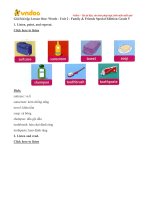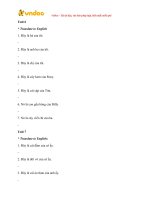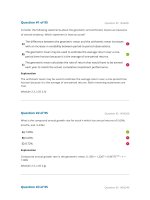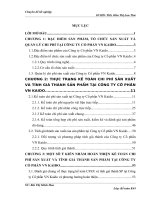a0009 algorithms and data structure morebook vn 4612
Bạn đang xem bản rút gọn của tài liệu. Xem và tải ngay bản đầy đủ của tài liệu tại đây (62.76 KB, 7 trang )
5
Algorithms and Data Structures
© N. Wirth 1985 (Oberon version: August 2004)
Contents
Preface
1 Fundamental Data Structures
1.1 Introduction
1.2 The Concept of Data Type
1.3 Primitive Data Types
1.4 Standard Primitive Types
1.4.1 Integer types
1.4.2 The type REAL
1.4.3 The type BOOLEAN
1.4.4 The type CHAR
1.4.5 The type SET
1.5 The Array Structure
1.6 The Record Structure
1.7 Representation of Arrays, Records, and Sets
1.7.1
Representation of Arrays
1.7.2
Representation of Recors
1.7.3
Representation of Sets
1.8 The File (Sequence)
1.8.1
Elementary File Operators
1.8.2
Buffering Sequences
1.8.3
Buffering between Concurrent Processes
1.8.4
Textual Input and Output
1.9 Searching
1.9.1
Linear Search
1.9.2
Binary Search
1.9.3
Table Search
1.9.4
Straight String Search
1.9.5
The Knuth-Morris-Pratt String Search
1.9.6
The Boyer-Moore String Search
Exercises
2 Sorting
2.1 Introduction
2.2 Sorting Arrays
2.2.1
Sorting by Straight Insertion
2.2.2
Sorting by Straight Selection
2.2.3
Sorting by Straight Exchange
2.3 Advanced Sorting Methods
2.3.1
Insertion Sort by Diminishing Increment
2.3.2
Tree Sort
2.3.3
Partition Sort
2.3.4
Finding the Median
2.3.5
A Comparison of Array Sorting Methods
2.4 Sorting Sequences
2.4.1
Straight Merging
2.4.2
Natural Merging
2.4.3
Balanced Multiway Merging
2.4.4
Polyphase Sort
2.4.5
Distribution of Initial Runs
Exercises
6
3 Recursive Algorithms
3.1 Introduction
3.2 When Not to Use Recursion
3.3 Two Examples of Recursive Programs
3.4 Backtracking Algorithms
3.5 The Eight Queens Problem
3.6 The Stable Marriage Problem
3.7 The Optimal Selection Problem
Exercises
4 Dynamic Information Structures
4.1 Recursive Data Types
4.2 Pointers
4.3 Linear Lists
4.3.1
Basic Operations
4.3.2
Ordered Lists and Reorganizing Lists
4.3.3
An Application: Topological Sorting
4.4 Tree Structures
4.4.1
Basic Concepts and Definitions
4.4.2
Basic Operations on Binary Trees
4.4.3
Tree Search and Insertion
4.4.4
Tree Deletion
4.4.5
Analysis of Tree Search and Insertion
4.5 Balanced Trees
4.5.1
Balanced Tree Insertion
4.5.2
Balanced Tree Deletion
4.6 Optimal Search Trees
4.7 B-Trees
4.7.1
Multiway B-Trees
4.7.2
Binary B-Trees
4.8 Priority Search Trees
Exercises
5 Key Transformations (Hashing)
5.1
Introduction
5.2
Choice of a Hash Function
5.3
Collision handling
5.4
Analysis of Key Transformation
Exercises
Appendices
A
The ASCII Character Set
B
The Syntax of Oberon
Index
7
Preface
In recent years the subject of computer programming has been recognized as a discipline whose mastery
is fundamental and crucial to the success of many engineering projects and which is amenable to
scientific treatement and presentation. It has advanced from a craft to an academic discipline. The initial
outstanding contributions toward this development were made by E.W. Dijkstra and C.A.R. Hoare.
Dijkstra's Notes on Structured Programming [1] opened a new view of programming as a scientific
subject and intellectual challenge, and it coined the title for a "revolution" in programming. Hoare's
Axiomatic Basis of Computer Programming [2] showed in a lucid manner that programs are amenable to
an exacting analysis based on mathematical reasoning. Both these papers argue convincingly that many
programmming errors can be prevented by making programmers aware of the methods and techniques
which they hitherto applied intuitively and often unconsciously. These papers focused their attention on
the aspects of composition and analysis of programs, or more explicitly, on the structure of algorithms
represented by program texts. Yet, it is abundantly clear that a systematic and scientific approach to
program construction primarily has a bearing in the case of large, complex programs which involve
complicated sets of data. Hence, a methodology of programming is also bound to include all aspects of
data structuring. Programs, after all, are concrete formulations of abstract algorithms based on particular
representations and structures of data. An outstanding contribution to bring order into the bewildering
variety of terminology and concepts on data structures was made by Hoare through his Notes on Data
Structuring [3]. It made clear that decisions about structuring data cannot be made without knowledge of
the algorithms applied to the data and that, vice versa, the structure and choice of algorithms often
depend strongly on the structure of the underlying data. In short, the subjects of program composition
and data structures are inseparably interwined.
Yet, this book starts with a chapter on data structure for two reasons. First, one has an intuitive feeling
that data precede algorithms: you must have some objects before you can perform operations on them.
Second, and this is the more immediate reason, this book assumes that the reader is familiar with the
basic notions of computer programming. Traditionally and sensibly, however, introductory programming
courses concentrate on algorithms operating on relatively simple structures of data. Hence, an
introductory chapter on data structures seems appropriate.
Throughout the book, and particularly in Chap. 1, we follow the theory and terminology expounded by
Hoare and realized in the programming language Pascal [4]. The essence of this theory is that data in the
first instance represent abstractions of real phenomena and are preferably formulated as abstract
structures not necessarily realized in common programming languages. In the process of program
construction the data representation is gradually refined -- in step with the refinement of the algorithm -to comply more and more with the constraints imposed by an available programming system [5]. We
therefore postulate a number of basic building principles of data structures, called the fundamental
structures. It is most important that they are constructs that are known to be quite easily implementable
on actual computers, for only in this case can they be considered the true elements of an actual data
representation, as the molecules emerging from the final step of refinements of the data description. They
are the record, the array (with fixed size), and the set. Not surprisingly, these basic building principles
correspond to mathematical notions that are fundamental as well.
A cornerstone of this theory of data structures is the distinction between fundamental and "advanced"
structures. The former are the molecules -- themselves built out of atoms -- that are the components of
the latter. Variables of a fundamental structure change only their value, but never their structure and
never the set of values they can assume. As a consequence, the size of the store they occupy remains
constant. "Advanced" structures, however, are characterized by their change of value and structure during
the execution of a program. More sophisticated techniques are therefore needed for their implementation.
The sequence appears as a hybrid in this classification. It certainly varies its length; but that change in
structure is of a trivial nature. Since the sequence plays a truly fundamental role in practically all
computer systems, its treatment is included in Chap. 1.
The second chapter treats sorting algorithms. It displays a variety of different methods, all serving the
same purpose. Mathematical analysis of some of these algorithms shows the advantages and
disadvantages of the methods, and it makes the programmer aware of the importance of analysis in the
8
choice of good solutions for a given problem. The partitioning into methods for sorting arrays and
methods for sorting files (often called internal and external sorting) exhibits the crucial influence of data
representation on the choice of applicable algorithms and on their complexity. The space allocated to
sorting would not be so large were it not for the fact that sorting constitutes an ideal vehicle for
illustrating so many principles of programming and situations occurring in most other applications. It
often seems that one could compose an entire programming course by deleting examples from sorting
only.
Another topic that is usually omitted in introductory programming courses but one that plays an
important role in the conception of many algorithmic solutions is recursion. Therefore, the third chapter
is devoted to recursive algorithms. Recursion is shown to be a generalization of repetition (iteration), and
as such it is an important and powerful concept in programming. In many programming tutorials, it is
unfortunately exemplified by cases in which simple iteration would suffice. Instead, Chap. 3 concentrates
on several examples of problems in which recursion allows for a most natural formulation of a solution,
whereas use of iteration would lead to obscure and cumbersome programs. The class of backtracking
algorithms emerges as an ideal application of recursion, but the most obvious candidates for the use of
recursion are algorithms operating on data whose structure is defined recursively. These cases are treated
in the last two chapters, for which the third chapter provides a welcome background.
Chapter 4 deals with dynamic data structures, i.e., with data that change their structure during the
execution of the program. It is shown that the recursive data structures are an important subclass of the
dynamic structures commonly used. Although a recursive definition is both natural and possible in these
cases, it is usually not used in practice. Instead, the mechanism used in its implementation is made
evident to the programmer by forcing him to use explicit reference or pointer variables. This book
follows this technique and reflects the present state of the art: Chapter 4 is devoted to programming with
pointers, to lists, trees and to examples involving even more complicated meshes of data. It presents what
is often (and somewhat inappropriately) called list processing. A fair amount of space is devoted to tree
organizations, and in particular to search trees. The chapter ends with a presentation of scatter tables, also
called "hash" codes, which are oftern preferred to search trees. This provides the possibility of comparing
two fundamentally different techniques for a frequently encountered application.
Programming is a constructive activity. How can a constructive, inventive activity be taught? One
method is to crystallize elementary composition priciples out many cases and exhibit them in a
systematic manner. But programming is a field of vast variety often involving complex intellectual
activities. The belief that it could ever be condensed into a sort of pure recipe teaching is mistaken. What
remains in our arsenal of teaching methods is the careful selection and presentation of master examples.
Naturally, we should not believe that every person is capable of gaining equally much from the study of
examples. It is the characteristic of this approach that much is left to the student, to his diligence and
intuition. This is particularly true of the relatively involved and long example programs. Their inclusion
in this book is not accidental. Longer programs are the prevalent case in practice, and they are much
more suitable for exhibiting that elusive but essential ingredient called style and orderly structure. They
are also meant to serve as exercises in the art of program reading, which too often is neglected in favor of
program writing. This is a primary motivation behind the inclusion of larger programs as examples in
their entirety. The reader is led through a gradual development of the program; he is given various
snapshots in the evolution of a program, whereby this development becomes manifest as a stepwise
refinement of the details. I consider it essential that programs are shown in final form with sufficient
attention to details, for in programming, the devil hides in the details. Although the mere presentation of
an algorithm's principle and its mathematical analysis may be stimulating and challenging to the
academic mind, it seems dishonest to the engineering practitioner. I have therefore strictly adhered to the
rule of presenting the final programs in a language in which they can actually be run on a computer.
Of course, this raises the problem of finding a form which at the same time is both machine executable
and sufficiently machine independent to be included in such a text. In this respect, neither widely used
languages nor abstract notations proved to be adequate. The language Pascal provides an appropriate
compromise; it had been developed with exactly this aim in mind, and it is therefore used throughout this
book. The programs can easily be understood by programmers who are familiar with some other highlevel language, such as ALGOL 60 or PL/1, because it is easy to understand the Pascal notation while
proceeding through the text. However, this not to say that some proparation would not be beneficial. The
9
book Systematic Programming [6] provides an ideal background because it is also based on the Pascal
notation. The present book was, however, not intended as a manual on the language Pascal; there exist
more appropriate texts for this purpose [7].
This book is a condensation -- and at the same time an elaboration -- of several courses on programming
taught at the Federal Institute of Technology (ETH) at Zürich. I owe many ideas and views expressed in
this book to discussions with my collaborators at ETH. In particular, I wish to thank Mr. H. Sandmayr for
his careful reading of the manuscript, and Miss Heidi Theiler and my wife for their care and patience in
typing the text. I should also like to mention the stimulating influence provided by meetings of the
Working Groups 2.1 and 2.3 of IFIP, and particularly the many memorable arguments I had on these
occasions with E. W. Dijkstra and C.A.R. Hoare. Last but not least, ETH generously provided the
environment and the computing facilities without which the preparation of this text would have been
impossible.
Zürich, Aug. 1975
1.
2.
3.
4.
5.
6.
7.
N. Wirth
In Structured Programming. O-.J. Dahl, E.W. Dijkstra, C.A.R. Hoare. F. Genuys, Ed. (New York;
Academic Press, 1972), pp. 1-82.
In Comm. ACM, 12, No. 10 (1969), 576-83.
In Structured Programming, pp. 83-174.
N. Wirth. The Programming Language Pascal. Acta Informatica, 1, No. 1 (1971), 35-63.
N. Wirth. Program Development by Stepwise Refinement. Comm. ACM, 14, No. 4 (1971), 221-27.
N. Wirth. Systematic Programming. (Englewood Cliffs, N.J. Prentice-Hall, Inc., 1973.)
K. Jensen and N. Wirth, PASCAL-User Manual and Report. (Berlin, Heidelberg, New York;
Springer-Verlag, 1974).
Preface To The 1985 Edition
This new Edition incorporates many revisions of details and several changes of more significant nature.
They were all motivated by experiences made in the ten years since the first Edition appeared. Most of
the contents and the style of the text, however, have been retained. We briefly summarize the major
alterations.
The major change which pervades the entire text concerns the programming language used to express the
algorithms. Pascal has been replaced by Modula-2. Although this change is of no fundamental influence
to the presentation of the algorithms, the choice is justified by the simpler and more elegant syntactic
structures of Modula-2, which often lead to a more lucid representation of an algorithm's structure. Apart
from this, it appeared advisable to use a notation that is rapidly gaining acceptance by a wide community,
because it is well-suited for the development of large programming systems. Nevertheless, the fact that
Pascal is Modula's ancestor is very evident and eases the task of a transition. The syntax of Modula is
summarized in the Appendix for easy reference.
As a direct consequence of this change of programming language, Sect. 1.11 on the sequential file
structure has been rewritten. Modula-2 does not offer a built-in file type. The revised Sect. 1.11 presents
the concept of a sequence as a data structure in a more general manner, and it introduces a set of program
modules that incorporate the sequence concept in Modula-2 specifically.
The last part of Chapter 1 is new. It is dedicated to the subject of searching and, starting out with linear
and binary search, leads to some recently invented fast string searching algorithms. In this section in
particular we use assertions and loop invariants to demonstrate the correctness of the presented
algorithms.
A new section on priority search trees rounds off the chapter on dynamic data structures. Also this
species of trees was unknown when the first Edition appeared. They allow an economical representation
and a fast search of point sets in a plane.
182
a
E
0.1
0.25
0.5
0.75
0.9
0.95
1.06
1.17
1.50
2.50
5.50
10.50
Table 4.7 Expected number of probes for linear probing.
Certainly the major disadvantage over techniques using dynamic allocation is that the size of the table is
fixed and cannot be adjusted to actual demand. A fairly good a priori estimate of the number of data items
to be classified is therefore mandatory if either poor storage utilization or poor performance (or even table
overflow) is to be avoided. Even if the number of items is exactly known -- an extremely rare case -- the
desire for good performance dictates to dimension the table slightly (say 10%) too large.
The second major deficiency of scatter storage techniques becomes evident if keys are not only to be
inserted and retrieved, but if they are also to be deleted. Deletion of entries in a hash table is extremely
cumbersome unless direct chaining in a separate overflow area is used. It is thus fair to say that tree
organizations are still attractive, and actually to be preferred, if the volume of data is largely unknown, is
strongly variable, and at times even decreases.
Exercises
5.1. If the amount of information associated with each key is relatively large (compared to the key itself),
this information should not be stored in the hash table. Explain why and propose a scheme for representing
such a set of data.
5.2. Consider the proposal to solve the clustering problem by constructing overflow trees instead of
overflow lists, i.e., of organizing those keys that collided as tree structures. Hence, each entry of the scatter
(hash) table can be considered as the root of a (possibly empty) tree. Compare the expected performance of
this tree hashing method with that of open addressing.
5.3. Devise a scheme that performs insertions and deletions in a hash table using quadratic increments for
collision resolution. Compare this scheme experimentally with the straight binary tree organization by
applying random sequences of keys for insertion and deletion.
5.4. The primary drawback of the hash table technique is that the size of the table has to be fixed at a time
when the actual number of entries is not known. Assume that your computer system incorporates a
dynamic storage allocation mechanism that allows to obtain storage at any time. Hence, when the hash
table H is full (or nearly full), a larger table H' is generated, and all keys in H are transferred to H',
whereafter the store for H can be returned to the storage administration. This is called rehashing. Write a
program that performs a rehash of a table H of size n.
5.5. Very often keys are not integers but sequences of letters. These words may greatly vary in length, and
therefore they cannot conveniently and economically be stored in key fields of fixed size. Write a program
that operates with a hash table and variable length keys.
References
5-1. W.D. Maurer. An Improved Hash Code for Scatter Storage. Comm. ACM, 11, No. 1 (1968), 35-38.
5-2. R. Morris. Scatter Storage Techniques. Comm. ACM, 11, No. 1 (1968), 38-43.
5-3. W.W. Peterson. Addressing for Random-access Storage. IBM J. Res. & Dev., 1, (1957), 130-46.
5-4. G. Schay and W. Spruth. Analysis of a File Addressing Method. Comm. ACM, 5, No. 8 459-62.
183




